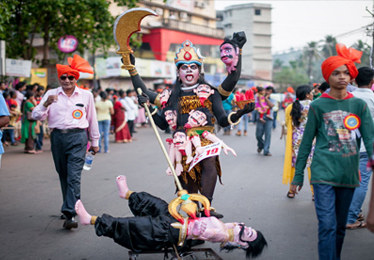Shigmotsav for Tourists in Goa
 Shigmotsav for Tourists in Goa
Shigmotsav for Tourists in Goa
GoanShigmo festival is a spring festival celebrated with a lot of fanfaronade on the full moon day on the Phalgun (March) month of the Hindu calendar. This vibrant and colourful festival draws tourists from all over the world. It is a good reason for the tourists to visit Goa to be part of the zeal and fervour exuded by this 25 year old festival of Goa, celebrated for a period of 14 days. The highlight of the festival is the meticulously crafted floats that depict the culture of Goa. The festival spans across a fortnight beginning on the 9th moon day to the full moon day and marks the end of winter and beginning of the harvest season.
The GoanShigmo festival begins with the Naman (song) and the collective obeisance of the villagers. On the first day, the village deity is bathed and dressed in saffron robes. After the offering of food, a feast is held. The 5th day is called 'Rang Panchami'. This day of rejoicing is celebrated with the profuse use of 'Gulal' or red powder. People smear gulal on each other as a gesture of greeting.On the 11th to 15th day, the villagers, clad in vibrant clothes carry dhwajas or torans along with beating drums and blowing the flutes, they assemble at the village temples.
They perform various folk dances like the 'Ghode-morni' or the horse dance,Talgadi, Hanpet, Lamp dance,Gopha,'Rommatamel' and 'Fugdi' dances are performed by the villagers as part of the festivity. The villagers dance and sing the various folk songs in the courtyard of the temple to the beat of their musical instruments, dhol and taso. During these dancers the villagers go into a frenzied dance and excitement and fervour grips the atmosphere. The floats move from the different towns as more participants enter the fray from the neighbouring villages. With the deepening of the night, the ardour becomes infectious and the dancers give way to the parades and floats.
The lofty figures of garishly painted demons and deities take the centre stage. These floats depict scenes from the mythology and reflect the culture of Goa. The mythological figures like Ravana, Sita, Kumbhafarna, demons, SugreevaSena, Lord Rama are exquisitely fabricated by the adroit artists and are indeed a feast for the eyes. The main themes of the dance performances seems to be on theMaratha warfare and thelegendary rulers of the area like the Kadambs, Rashtrakuts, Chalukyas, Silahars, Muslims,Bahamani and the Portuguese.
Elements of the GoanShigmo festival, like the ghudis, lalkhi, taranga, and bonderam are placed at various locations across the entire stretch from Divja circle to the Kala Academy in Panaji. The main attraction, the Shigmo Parade starts from Ponda and proceeds to Valpoi, Curchorem, Pernem, Panjim, Sanguem, Argao, Mapusa, Vasco, Bicholim, Quepem, Cuncolim, Sanquelim and Canacona over its 15-day course. The Shigmotsav Parade is organised by the PanajiShigmotsavSamiti in association with the Panaji Municipal Council (PMC) and Goa Tourism.
The Goa government and the Tourism Department offer tremendous support to the celebration of the GoanShigmo festival and ensure that the celebration takes place peacefully and with a lot of fanfare and pomp. A spectacular display of the Goan Hindu ethnicity and the mythology is on show as the annual Shigmo parade holds centrestage on Panjim's 18th June Road every year. Clad in the traditional costumes, the folk groups comprising of women dancers deliver outstanding performances of various dances. These are intercepted by the Romtamell groups that move along the route in their traditional Goan drums. The grand finale is offered by the brilliantly designed and adorned floats.
Shigmotsava is surely a crowd puller and tourists not only from the different parts of the country but various parts of the world throng to the city of Goa during this time(Mid-March-Mid April) to watch the marvellous parades and floatsand be a part of the fervour and zest the GoanShigmo festival has to offer.






